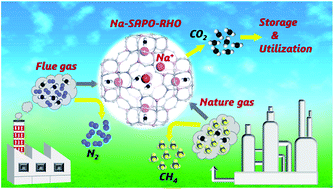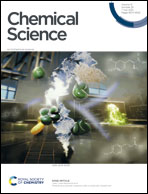The inorganic cation-tailored “trapdoor” effect of silicoaluminophosphate zeolite for highly selective CO2 separation†
Abstract
Functional nanoporous materials are widely explored for CO2 separation, in particular, small-pore aluminosilicate zeolites having a “trapdoor” effect. Such an effect allows the specific adsorbate to push away the sited cations inside the window followed by exclusive admission to the zeolite pores, which is more advantageous for highly selective CO2 separation. Herein, we demonstrated that the protonated organic structure-directing agent in the small-pore silicoaluminophosphate (SAPO) RHO zeolite can be directly exchanged with Na+, K+, or Cs+ and that the Na+ form of SAPO-RHO exhibited unprecedented separation for CO2/CH4, superior to all of the nanoporous materials reported to date. Rietveld refinement revealed that Na+ is sited in the center of the single eight-membered ring (s8r), while K+ and Cs+ are sited in the center of the double 8-rings (d8rs). Theoretical calculations showed that the interaction between Na+ and the s8r in SAPO-RHO was stronger than that in aluminosilicate RHO, giving an enhanced “trapdoor” effect and record high selectivity for CO2 with the separation factor of 2196 for CO2/CH4 (0.02/0.98 bar). The separation factor of Na-SAPO-RHO for CO2/N2 was 196, which was the top level among zeolitic materials. This work opens a new avenue for gas separation by using diverse silicoaluminophosphate zeolites in terms of the cation-tailored “trapdoor” effect.

- This article is part of the themed collection: In celebration of Chinese New Year, 2022


 Please wait while we load your content...
Please wait while we load your content...